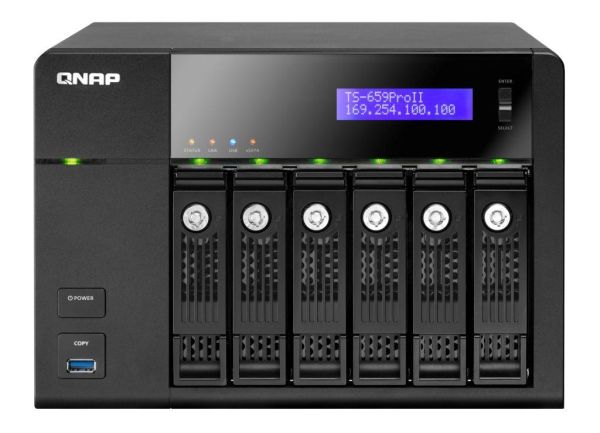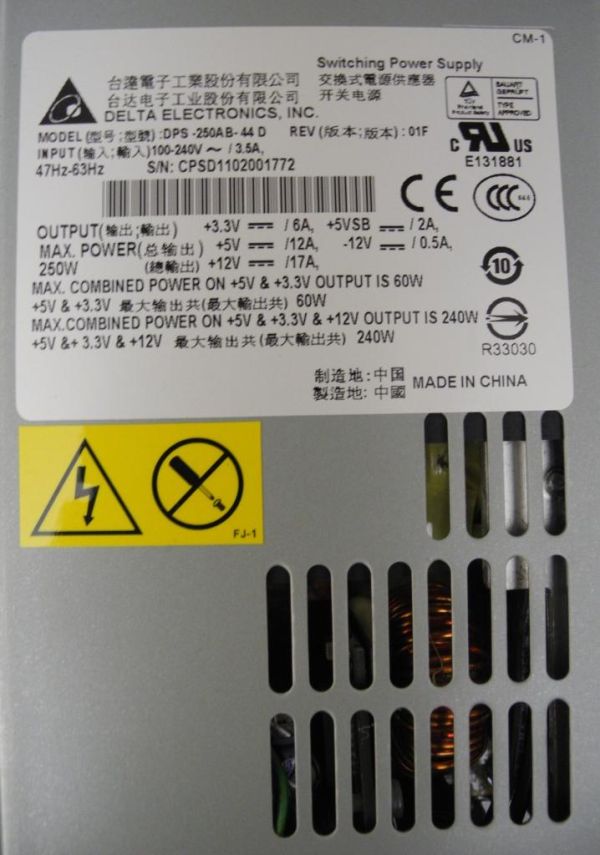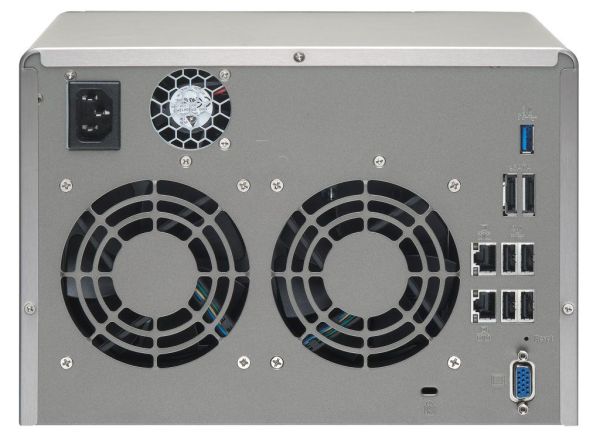QNAP TS-659 Pro II Review
by Ganesh T S on September 19, 2011 8:00 AM EST- Posted in
- IT Computing
- NAS
- QNAP
The QNAP TS-659 Pro II review unit came bundled with 6 Samsung HD103SJ hard drives. The unit also had the Turbo NAS firmware pre-installed, and so, it was almost pure plug and play.
The contents of the TS-659 Pro II package are as below:
- QNAP TS-659 Pro II chassis
- 6 x 1TB Samsung HD103SJ 7200rpm drives inside the chassis (Retail unit is BYOD)
- 2 x 3ft Cat 5E Ethernet cables
- CD with QNAP Finder and miscellaneous software / user guides
- Getting Started guide
- Screws for hard disk installation
- Keys for the hard drive bays
- Three-pronged US power cable
The TS-659 Pro II chassis is aesthetically pleasing, with a curved brushed steel finish on the top and the sides.
On the front panel, we have the drive bays occupying a major portion at the bottom right corner. Directly above it, there are a row of LEDs to indicate activity on each of the hard disks. On top of this, we have the Status, LAN, USB and eSATA LED indicators. At the top right of the front panel, we have a two row mono LCD display with a blue backlight which is useful when configuring the unit without a PC. There are 'Enter' and 'Select' buttons to interact with the options appearing in the LCD display. On the left side of the front panel, we have the QNAP logo at the top, the power status LED below it and the Power button. Directly beneath that is the first USB 3.0 port with a one-touch Copy button.
Unlike the other NAS units we have reviewed before, the power supply is inbuilt into the chassis. At the rear of the unit, we have a slot to plug in the power cable.
The power supply itself has a small fan, and there are two big fans to cool down the hard disks. Four USB 2.0 ports and two GbE ports make up the right side of the fans. Below this is the reserved VGA output. Above it, we have two eSATA ports and the second USB 3.0 port. A Kensington lock wraps up the rear of the unit.
The hard drive bays can accommodate both 3.5" and 2.5" hard drives and SSDs, and the screw holes are clearly marked out for each. The key slot in front of each bay can be used to make sure that the drive stays securely in place and also does its bit to ensure data security along with the Kensington lock.
In the next section, we will deal with the setup process and also cover the various features of the QNAP Turbo NAS firmware.














69 Comments
View All Comments
jmelgaard - Monday, September 19, 2011 - link
I Use the PS3 Media Server instead of the built-in one to stream to a PS3.I must admit I have not tried streaming directly to my Sony DLNA enabled TV as I have gotten to use to using the PS3.
But it might be worth trying to see if it narrows the cases where the format is unsupported.
saiga6360 - Monday, September 19, 2011 - link
You will probably run into the same issue, which is really a Sony issue not supporting media formats. In which case, you will be stuck with a PC in between your storage and media player. As NAS hardware continue to upgrade to more powerful CPUs then maybe a better integrated DLNA media server can become possible.jmelgaard - Tuesday, September 20, 2011 - link
The point is that the PS3 has the same issue, many formats are unsupported by the PS3.The PS3 media server is therefore aimed to transcode unsupported medias to a format that the PS3 supports, so this should narrow the cases unless it chooses to transcode into a format that a TV does not support.
There is a bunch of settings for the various encoders, but to what degree you can control what is transcoded by default and what the output is I don't know.
jmelgaard - Tuesday, September 20, 2011 - link
Oh and the whole point of choosing the PS3 media server over any others was just that it already has a Pre-build QPKG for QNAP users making the installation a blizz...For other NAS types it's a different story.
jwcalla - Monday, September 19, 2011 - link
I'm somewhat surprised by the (relatively) poor NFS performance. Were the hard disks left in ext4 configuration or formatted to NTFS before the tests?ganeshts - Monday, September 19, 2011 - link
NFS performance could be improved by playing around with the mount options. We just tabulated the values at the default settings. The disks were in EXT4 only.Sivar - Monday, September 19, 2011 - link
A know of several businesses looking for something just like this. Your article was not only well-written and informative, you also have a clue about image formats so didn't use JPEG, which is horribly inefficient for screen shots like the ones in the article.SeeManRun - Monday, September 19, 2011 - link
Hi Ganesh,I read the article as I am very interested in getting a NAS or building my own. One thing that appears to be a limit for all of these machines is the speed at which you can transfer data from them. It seems to me with dual gigabit ethernet ports bonded, you should be able to see above 110 megabytes per second. I have read on smallnetbuilder that almost no NAS can get above this limit. Do you happen to know why, or care to explore this?
Thanks
tbutler - Monday, September 19, 2011 - link
Question that wasn't answered in the review: are the eSATA ports on this box compatible with port multipliers?ganeshts - Monday, September 19, 2011 - link
Thanks for bringing this to my attention.I just checked it out myself and am able to confirm that the eSATA ports are compatible with port multipliers.